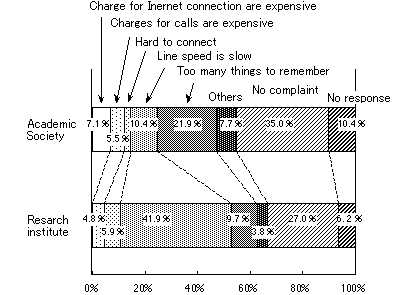2. Summary of Survey Results
1999-01-25
This section summarizes the results of the survey and discusses the status of Internet usage while contrasting academic societies and research institutes based on the results. The survey results, which constitute the basis of this section, are represented by Appendix A: Survey Results. In addition, the questionnaire sheet is attached as Appendix B: Questionnaire Sheet.
2.1 Status of the Information Infrastructure
In order to grasp the status of the information infrastructure of each user, respondents were asked about the installation status of their computers or LANs. Table 2-1 shows the number of computers on an installed basis and the status of the computer network per person at an academic society. Computers are installed at approx. 80% of academic societies while approx. 30% have installed an average of more than one computer per person. Concerning networks, 30% of the respondents have installed LANs that are connected to the Internet. Those who replied "connected to only LANs" represented only 2.8%, indicating that most academic societies that have installed LANs are connected to the Internet. On the other hand, approx. 23% of academic societies are not connected to networks although they have computers. As a result of cross aggregating the number of installed computers and the status of networks, it was found that as the number of installed computers per person increased, the ratio of network connection also increased. However, this trend was not highly significant.
| Status of network | ||||||||
| No computer | Not connected | LAN only | Internet only | LAN & Internet | Do not know | Total | ||
| Number of installed computers per person | Not installed | 20.6% | - | - | - | - | - | 20.6% |
| 1 computer per 5 people | - | 4.0% | - | 1.7% | 3.8% | 0.2% | 9.8% | |
| 1 computer per 3 to 4 people | - | 3.8% | 0.2% | 1.9% | 1.3% | 0.4% | 7.7% | |
| 1 computer per 1 to 2 people | - | 10.0% | 1.1% | 6.6% | 10.2% | 0.6% | 28.5% | |
| More than 1 computer per person | - | 4.9% | 1.5% | 7.2% | 14.3% | - | 27.9% | |
| Total | 20.6% | 22.8% | 2.8% | 17.4% | 29.6% | 1.3% | 94.5% | |
| Status of network | ||||||||
| No computer | Not connected | LAN only | Internet only | LAN & Internet | Do not know | Total | ||
| Number of installed computers per person | Not installed | 0.3% | - | - | - | - | - | 0.3% |
| 1 computer per 5 people | - | 0.3% | - | 0.3% | 2.7% | - | 3.4% | |
| 1 computer per 3 to 4 people | - | 0.3% | - | 1.0% | 16.3% | - | 17.6% | |
| 1 computer per 1 to 2 people | - | 0.3% | - | 0.7% | 40.7% | - | 41.7% | |
| More than 1 computer per person | - | 0.3% | - | 1.0% | 34.6% | 0.3% | 36.3% | |
| Total | 0.3% | 1.4% | - | 3.1% | 94.2% | 0.3% | 99.3% | |
Table 2-2 shows the number of installed computers per wperson at each research institute and the status of computer networks. 99.7% of research institutes have computers installed, while 36.3% have more than 1 computer per person. In terms of the status of networks, those research institutes with LANs and connected to the Internet account for 94.2%. Summarizing the status of information infrastructures at research institutes, more than 90% have 1 computer per 1 to 2 people, have installed LANs and are connected to the Internet.
2.2 Diffusion of the Internet and Methods of Connection
Figure 2-1 shows the status of Internet usage at academic societies. Of the academic societies surveyed, 37.7% use the Internet while those not using the Internet account for 60.2%. Thus, those using the Internet are still a minority. Regarding years/months of using the Internet, approx. 65% of all the academic societies have 2 years or less experience in using the Internet; this is shorter than research institutes, which are described later. By types of lines for connection, 54.4% use leased lines while 36.3% use dial-up connections. In terms of connection targets by ratio, universities/colleges or institutions with close relationships represent 45.1%, commercial service providers account for 35.2%, and Science Information Network (SINET) 7.1%.
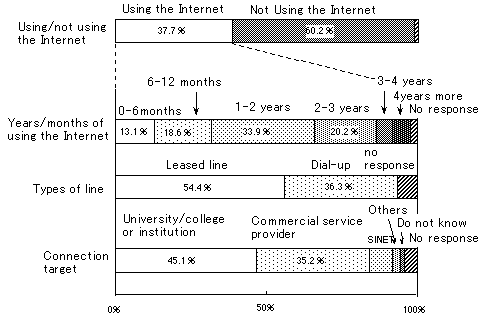
Figure 2-2 indicates the status of using the Internet at research institutes. Those using the Internet represent 96.9% while those not account for 2.0%. Concerning years of using the Internet, in contrast to academic societies, approx. 60% have used the Internet for more than 3 years. By types of connection line, leased lines represent 91.7% while dial-up connections account for 5.5%. In terms of connection targets, universities/colleges or institutions with which they are affiliated account for 95.5% while commercial service providers represent only 1.0%. Most universities/colleges had installed LANs as platforms for Internet connection before WWW became widespread, and it can be said that this effect is reflected in the high percentage of Internet use at research institutes.
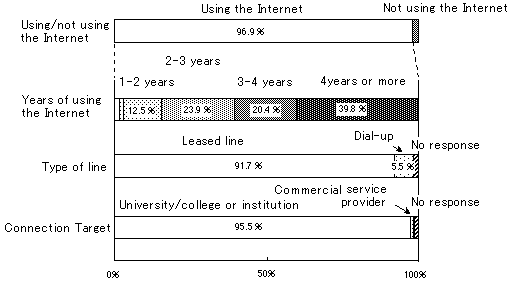
2.3 Means of Communication and Use of the Internet
In order to identify the extent to which the Internet is used for everyday communication at academic societies, we asked about the means used for communication between society secretariats and members and among sub-societies. Assuming 3 patterns of communication: 1) communication between a secretariat and a member (1 to 1); 2) communication from a secretariat to multiple members (1 to multiple); and 3) communication among sub-societies/working groups within a society (multiple to multiple), we asked about the means for each pattern. Figure 2-3 shows the means of communication in using the Internet at academic societies. Regardless of communication patterns, it indicates that postal mail is the most frequently used means. As for other means, telephone is used most frequently in 1-to-1 communication, while fax is used almost equally in both 1-to-1 and 1-to-multiple communications. In comparison to these 3 means, the Internet's representative services - E-mail, mailing lists and Web pages - are far less frequently used. In terms of communication patterns, E-mail is used most frequently in "multiple-to-multiple" communication, followed by "1-to-1" and "1-to-multiple" communications. This is a unique characteristic of E-mail, not offered by other means. Mailing lists are used most frequently in "multiple-to-multiple" communication, followed by "1-to-multiple" and "1-to-1" communications. This is also a unique characteristic of mailing lists. Web pages are used most frequently in "1-to-multiple" communication. Although postal mail shows a similar tendency, the characteristic of Web pages is much more outstanding. In the following graph, the "others" category, which shows a similar tendency to Web pages, includes member's magazines, bulletins and newsletters.
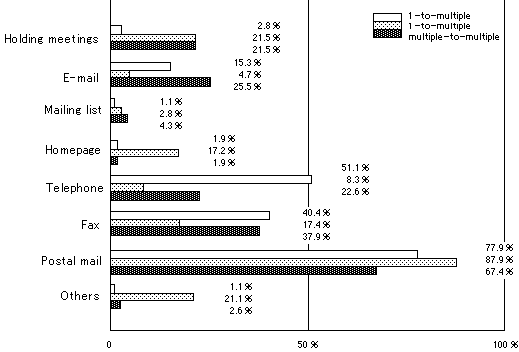
Figure 2-3. Means of communication used at academic societies
Research institutes were asked about the means of communication with joint project members. The result is given in Figure 2-4. E-mail is the most used means followed by fax.
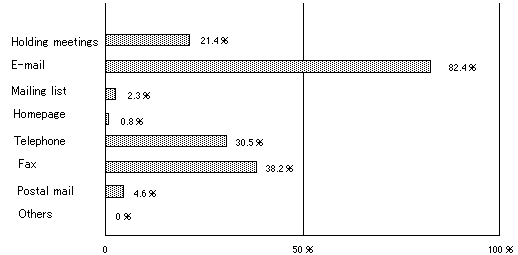
Figure 2-4. Means of communication at laboratories
2.4 Use of E-mail
We asked academic societies and research institutes about the ratio of members and co-researchers whose mail addresses are identified and the problems in the use of E-mail. Figure 2-5 shows the ratio of those whose E-mail addresses are identified. Of the academic societies, 56.8% replied: "almost no addresses are identified." By contrast, of the research institutes, 71.8% replied: "most addresses are identified."
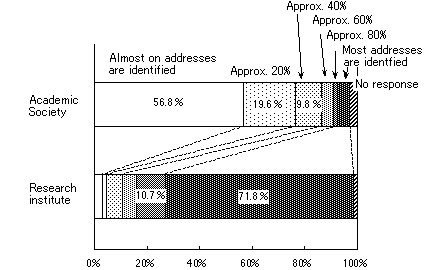
Figure 2-6 shows the result of responses on the problems in using E-mails. Of the responses by academic societies, "cannot collectively send/handle E-mails since not all mail addresses of members are identified" represented the largest percentage. By contrast, in the case of research institutes, "cannot confirm if mails have been read by the recipients" represented the largest percentage. Of the other responses by research institutes, percentages of "difficult to communicate nuance" and "have no particular problem" were more than twice as common as the same responses by academic societies. Other problems indicated by academic societies and research institutes included uncertainty of secrecy of E-mails and inability to gain consensus among members, and the fact that E-mails are not suitable for non-text based communications, respectively. In addition, the problem of corrupted text was indicated by both academic societies and research institutes.
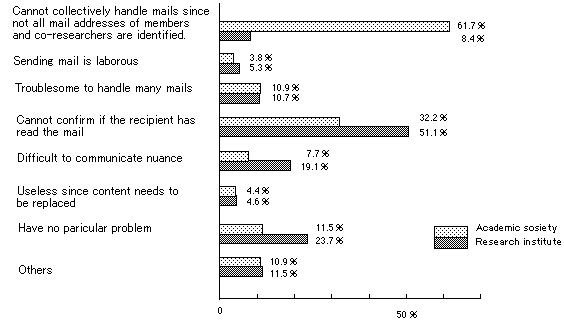
2.5 Use of Web Pages
We asked those academic societies and research institutes using the Internet about whether they have Web pages, Web page contents, problems in operating Web pages, etc. Figure 2-7 shows the status of Web pages by academic societies. Of the academic societies using the Internet, those having Web pages, including exclusive pages for members, accounted for 81.2%. The most common form of operating WWW servers necessary for opening Web pages was "Academic Society HomeVillage" provided by the National Center for Science Information Systems (NACSIS), which accounted for 36.5%. The second most common form was servers of universities related to academic societies, representing 31.8%. Of the academic societies operating Web pages, 78.7% produce and update the contents within their societies, while those outsourcing such work accounted for only 4.5%. Many of the people doing Web page production and updating are society officials or members who are making these efforts on a voluntary basis.
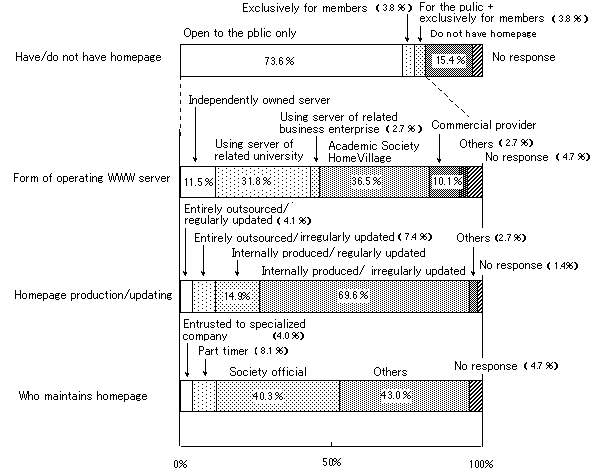
Web Concerning Web page contents, there are more societies that provide introduction of themselves, announcement of conferences/annual meetings, announcement of study meetings/seminars, and contents of thesis journals than those providing contents of societies' journals and thesis journals. Presumably, this is due to time and labor required in Web page updating, and the need for obtaining consensus of contributors, authenticating members and establishing billing systems. We asked those societies who have opened Web pages about the effects and many replied: "PR activities became efficient" and "services for society members were improved." However, some also pointed out that there was no means to evaluate effects, such as "there are merits, but they cannot be confirmed." Figure 2-8 indicates the status of Web pages by research institutes. Those research institutes operating Web pages represent 53.6% of all the research institutes using the Internet. Regarding forms of operating WWW servers, using universities' servers was the most common form, accounting for approx. 60% of those research institutes operating Web pages. Concerning the maintenance of Web pages, those research institutes internally producing and updating their Web pages represent approx. 90%, and in most cases, students or teaching staff maintain Web pages. As for Web page contents, study subjects and introduction of researchers/students represent high percentages. In terms of the proportion of Internet users and experiences in using the Internet, research institutes exceeded academic societies. However, for the ratio of operating Web pages, research institutes were only half as common as academic societies.
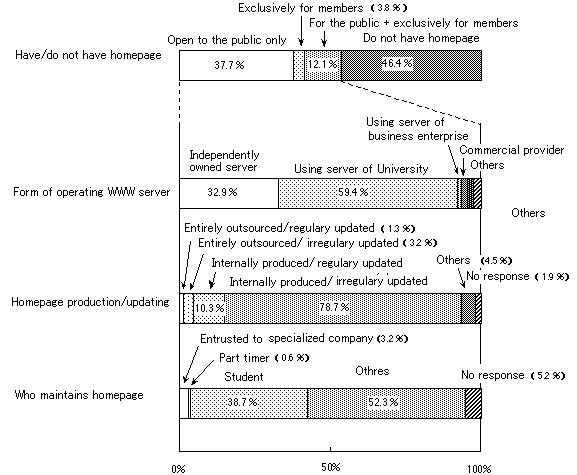
We asked academic societies and research institutes about problems concerning Web page operation. The result is shown in Figure 2-9. Of both academic societies and research institutes, approx. 80% have some problems, and the biggest problem is that there are few or no suitable human resources. Asked about the reason, those societies and research institutes not having Web pages listed "want to have Web page, but it will take much time and labor" as the main reason. It indicates that research institutes with Web pages and those without Web pages strongly want to produce them easily.
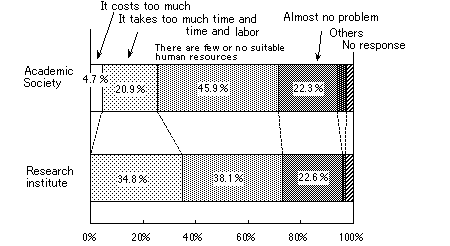
2.6 Need and Effect of the Internet
We asked academic societies and research institutes about how much they need the Internet. The result is given in Figure 2-10. Of the responses by the academic societies, "convenient to use" represented the highest proportion, accounting for 38.1%. In contrast, "essential" was the most common response by the research institutes and represented 53.9%. Table 2-3 indicates the result of cross aggregating responses by academic societies on using/not using the Internet. It shows a wide gap between those societies using the Internet and those not using it. Although those societies already using the Internet naturally consider it necessary, it is interesting to see that more than a half of those not using the Internet accept its convenience as they regard it as "convenient to use."
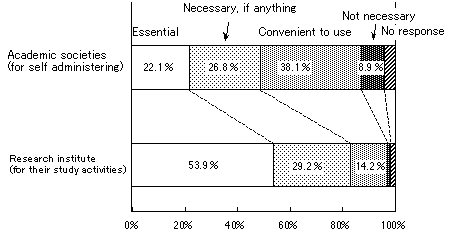
| Using/not using the Internet | |||
| Using it | Not using it | Total | |
| Essential | 16.8 % | 5.3 % | 22.1 % |
| Necessary, if anything | 12.1 % | 14.7 % | 26.8 % |
| Convenient to use | 8.1 % | 30.0 % | 38.1 % |
| Not necessary | 0.6 % | 8.3 % | 8.9 % |
| Total | 37.7 % | 58.3 % | No response=4.0% |
We asked academic societies about the effect of the Internet on the running of the organizations and the areas of their study, and research institutes about the same matters in regard to the areas of their study. The result is given in Figure 2-11. As for the academic societies, the most common response was "has effect on both the study areas and the running of the society," which represented 41.5%. Similarly, of the research institutes 59.0% replied that the Internet "has effect on the study areas."
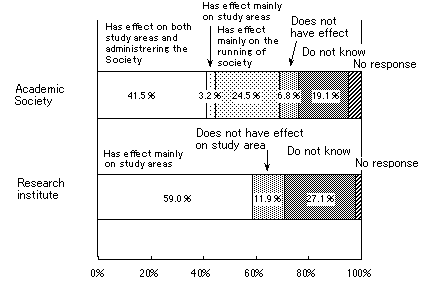
We asked academic societies about specific effects of the Internet. Common responses included effects on work efficiency such as "reduction of time spent on contacting members and collecting contributions" and effects on PR such as "increase in the number of members due to the provision of information to an unspecified number of people." In addition, it has been learned that the Internet has become essential in certain areas; for example, "checking databases on genes on the Internet is a prerequisite for writing contributions." Regarding the question to research institutes about specific effects of the Internet, they indicated benefits brought about by increased speed of data transmission such as "speeding up of research progress" and "enhanced quick-action of the announcement of achievements," effects in expanding study areas such as "formation of extensive relationships with researchers" and "progress of study in joint research and interdisciplinary areas," and effects in expanding communication areas such as "increased interchanges with foreign researchers" and "Internet is essential for international joint research." On the other hand, there were also opinions that indicated negative effects, such as "increased chores" and "excessive information." Concerning interchange between researchers, responses included such opinions as "it facilitates research in boundary areas in cooperation with researchers in various areas" and an individual level response: "found a joint researcher." Thus, it became clear that there are many cases indicating substantial effects of the Internet on joint research projects.
2.7 Complaints about and Requests of the Internet
We asked those academic societies and research institutes using the Internet about their complaints regarding the use. The result is shown in Figure 2-12. The most common response by the societies was "no complaint," which represented 35.8% of all responses. By contrast, among the research institutes, the most common response was "speed of the line is slow," accounting for 41.9%. When comparing academic societies and research institutes, complaints about communication speeds such as "hard to connect" and "slow line speed" were conspicuous with research institutes. Since most research institutes are connected with leased lines, these complaints reflect the high level of demand by research institutes that use the Internet on a daily basis. In contrast, such complaints as "there are too many things to remember" are common with the academic societies, indicating that they have less experience in using the Internet than research institutes do. Of descriptive responses by academic societies, there are many requests for technical support such as "need human resources to consult about the system." Included in descriptive responses by research institutes were many requests for faster communication, such as "want to enhance external communication with SINET."
